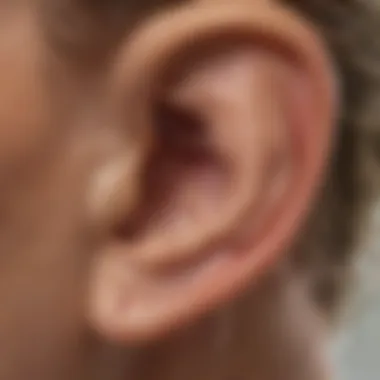Recognizing Damaged Eardrum Symptoms and Causes


Intro
When it comes to enjoying the thrill of surfing, most enthusiasts focus on the waves and wind, often neglecting one important aspect: ear health. The ears, particularly the eardrum, can take a beating from the elements, especially for those who frequently find themselves submerged in water. Labeled a silent bystander, a damaged eardrum can be a hidden concern that affects not just hearing but overall well-being.
Understanding the signs of a damaged eardrum is essential for surfers, as the consequences of neglect can lead to further complications. The eardrum is a delicate membrane that plays a crucial role in our auditory system, vibrating to transmit sound waves and working as a barrier to protect inner ear structures. But what happens when this advocacy is compromised? This guide aims to shed light on the symptoms, causes, and preventive measures linked to eardrum damage, ensuring that surfers can actively recognize issues before they escalate.
Equipped with this knowledge, one can enjoy surfing with the assurance that their ear health is safeguarded. From proper gear to essential techniques, let’s dive deeper.
Understanding the Eardrum
An often-overlooked aspect of our hearing health is the eardrum, a thin membrane that plays a crucial role in how we perceive sound. Understanding the eardrum is vital for several reasons, especially for those engaged in activities such as surfing or any other sport where exposure to harsh environmental conditions is likely. The health of your eardrum can impact your overall hearing ability and balance, which are essential not just for daily life but also for active pursuits.
The eardrum, also known as the tympanic membrane, acts as a boundary between the outer ear and middle ear. When sound waves hit the eardrum, it vibrates, transmitting sound information to the tiny bones in the middle ear, which then amplify the sound before passing it to the inner ear.
Key Benefits of Understanding the Eardrum
- Awareness of Damage Signs: A solid grasp of the anatomy and function can help individuals recognize potential damage early.
- Informed Decisions: Knowing how external factors like water pressure or loud noises affect the eardrum can guide informed choices during activities.
- Preventive care: Understanding the eardrum’s role encourages preventive measures, ensuring better ear health over time.
Understanding the eardrum isn’t just about knowledge. It is about safeguarding your auditory system against future damage and appreciating the delicate mechanism that allows us to engage fully with our surroundings. It’s easier to protect what you understand, making this awareness pivotal for everyone—especially surfers who frequently navigate turbulent waters.
Anatomy of the Eardrum
The eardrum is a remarkable structure, comprising several layers that contribute to its strength and functionality. It is about eight millimeters in diameter, roughly the size of a nickel. These layers include:
- Outer Layer: A thin epithelial layer that serves as the initial barrier against external contaminants.
- Middle Layer: A fibrous layer that provides structural support and is primarily responsible for the vibration that occurs when sound waves hit.
- Inner Layer: This layer consists of a mucous membrane that helps keep the eardrum moist.
Each layer has a distinct function, working in tandem to maintain health. This anatomy allows for optimal sound transmission. The integrity of the eardrum can be affected by various conditions—from minor injuries to infections, all of which compromise its ability to vibrate and transmit sound effectively.
Function of the Eardrum in Hearing
The pivotal role of the eardrum can’t be overstated. When sound waves travel through the air and reach the eardrum, they cause it to vibrate. These vibrationsthey do not merely create sound; they are the first step in processing that sound into something we can comprehend. The eardrum transmits these vibrations to three small bones known as ossicles in the middle ear called the malleus, incus, and stapes. This relay system amplifies the sound before it moves on to the cochlea in the inner ear.
In addition to sound transmission, the eardrum plays a significant role in protecting the inner ear from foreign objects and water. It’s this dual function—both auditory and protective—that makes the eardrum such an essential element of our hearing apparatus. Being active in environments that can lead to injury can often put the eardrum at risk.
Understanding these fundamentals is not just academic; it provides insights into how we experience sound and emphasizing how crucial it is to take care of our ears, especially for those who immerse themselves in recreational activities.
Causes of Eardrum Damage
The eardrum, known as the tympanic membrane, plays a crucial role in our auditory system. It's not just a mere barrier; it vibrates with incoming sound waves and transmits these vibrations to the tiny bones in the middle ear. When the eardrum is damaged, it can lead to various complications, including hearing loss and chronic ear problems. Understanding the causes of eardrum damage is paramount, especially for those engaging in activities like surfing or traveling, where exposure to environmental factors can be a daily occurrence. Each cause has its own nuances and implications, making awareness essential for preventive measures.
Trauma and Physical Injury
Trauma to the eardrum often occurs unexpectedly. It can be as innocent as a direct blow to the head during a fall, or even as simple as vigorous cleaning of the ear canal with cotton swabs. Surfers, frequently facing waves and potential wipeouts, may not realize that a sudden impact can cause a ruptured or perforated eardrum. The symptoms might start mild, like a sudden ringing in the ears, but can escalate to significant pain and even temporary hearing loss. The idea is to treat the ear with respect, recognizing that it’s fragile and can be easily damaged.
Infections and Inflammation
Infections are another common culprit. Otitis media, for instance, is an infection of the middle ear that often arises from sinus infections or colds, pushing fluid behind the eardrum. This pressure can lead to pain and potential rupture. For surfers and those frequently in the water, water exposure can facilitate bacterial growth, increasing the likelihood of inflammation and infection. It's like giving bacteria a free ride when you dive into murky waters; hence it's advisable to keep ears dry and to seek medical attention at the first sign of discomfort.


Sudden Pressure Changes
Sudden changes in air pressure can wreak havoc on the eardrum. Think about those moments when you’re swimming underwater, or flying in a plane; when altitude shifts occur rapidly, the equalization of pressure can become a tricky task. If the pressure inside the ear cannot balance with the external environment, it can result in discomfort, pain, and possible rupture. Learning simple techniques like yawning or chewing gum can help mitigate these effects. For individuals who are regularly exposed to changing pressures, maintaining awareness can prevent long-term ear damage.
Chronic Noise Exposure
Chronic noise exposure is an often-overlooked factor in eardrum damage. Prolonged exposure to loud sounds—whether from music, machinery, or even nature—can erode the ear’s sensitivity over time. Surfers on crowded beaches or loud sports events may not realize that their eardrums are under siege. It’s vital to protect those delicate membranes by minimizing exposure or using earplugs designed for water activities. Tinnitus, or persistent ringing in the ears, can be a wake-up call that something's not right, and being proactive about noise exposure is key to preserving long-term ear health.
Understanding these causes is essential for recognizing the signs early on and taking appropriate actions. Neglecting ear health can lead to complications that require medical intervention and may permanently affect your hearing.
Recognizing Symptoms of Eardrum Damage
Before diving into the various signs of eardrum damage, it's essential to consider why being able to recognize these symptoms is crucial for your health. The eardrum serves a vital role in your overall auditory process. When it suffers damage, not only can it lead to hearing issues, but it can also indicate underlying medical problems. Awarness of the signs allows for timely interventions, minimizing the risk of permanent complications.
Hearing Loss
One of the first indicators that something’s amiss with your eardrum is changes in hearing. This can manifest not just as a general dullness but can vary widely. You might experience difficulty distinguishing words in a conversation or perhaps sounds that you once heard clearly now seem muffled. Moreover, the world might feel quieter, making it hard to engage in everyday activities or even enjoy your favorite music at a surf spot.
It's worth noting that hearing loss can be partial or complete. A sudden onset, especially after accidents or water exposure, should serve as a red flag.
Ear Pain and Discomfort
If you feel a nagging pain in your ear, it's another symptom that shouldn't be brushed off. Sometimes, this pain can be sharp and sudden, while at other times it may come across as a dull ache. This discomfort can be a result of pressure changes, fluid accumulation, or even an infection. If you're surfing and end up taking a tumble, your ear may take a hit, leading to both physical pain and emotional distress.
In addition to the pain, there might be a sensation of fullness or pressure in the ear, often coupled with an urgency to adjust your ear pressure. Ignoring this might worsen your condition, making it all the more important to stay attuned to how your ears feel.
Fluid Discharge from the Ear
One telltale sign of eardrum damage is the presence of fluid coming from the ear. This discharge may vary in consistency and color, often ranging from clear to yellowish or even bloody. Surfboards and water activities can lead to water getting trapped, creating a breeding ground for bacteria, which can lead to infections.
Ringing or Buzzing Sounds
Tinnitus is another symptom often associated with eardrum issues. If you begin hearing a constant ringing, buzzing, or hissing sound in your ears, it may be linked to eardrum damage. This persistent sound can be distracting and cause stress, especially when trying to focus on your tasks or while enjoying the waves.
Such sounds can be triggered by various factors like pressure changes or traumatic injuries to the ear. It’s advisable to consult a healthcare professional if it persists or worsens.
Balance Issues
Finally, balance issues can arise from eardrum damage, given the ear's role in equilibrium. If you find yourself feeling dizzy or off-kilter after exposure to loud noises, pressure changes, or even after wipeouts, it might reflect an underlying problem with your eardrum.
Caring for your ears is not only about your hearing but also allows you to maintain your active lifestyle. This can be significant if you’re regularly engaging in surfing or similar activities, as the last thing you want is to feel weak on your feet while out in the water.
Diagnosis of Eardrum Damage
Diagnosing eardrum damage is a crucial step in addressing potential issues that could lead to long-term hearing loss or discomfort. A thorough diagnosis not only helps pinpoint the exact nature of the problem but also guides effective treatment options. Understanding this process can be especially important for surfers and outdoor enthusiasts, who frequently expose their ears to water and environmental stressors.
The diagnosis typically involves a combination of medical history review, physical checks, and specific tests. This ensures a comprehensive understanding of the individual's situation, which enhances the accuracy of the findings.
Medical History and Physical Examination


In this initial phase, the healthcare provider collects detailed information regarding the patient’s medical history. This could include previous ear infections, injuries, or ongoing symptoms like pain or dizziness.
Here are some key points that might be discussed:
- Recent Injuries: How did the injury occur? Was there a loud sound or physical impact?
- Current Symptoms: Are there issues like ringing in the ears, balance problems, or fluid discharge?
- Previous Conditions: Any history of otitis media or other chronic ear conditions?
The physical examination often involves a general check-up of the ears, where the doctor looks for visible signs of damage or infection. This step is vital because it sets the tone for further testing, particularly if the injury mechanism or symptoms suggest a serious condition.
Otoscopy: A Visual Examination
This part of the diagnosis relies on the otoscope, a specialized tool that allows the healthcare provider to visualize the eardrum closely. Otoscopy provides a window into the ear canal, making it possible to observe any abnormalities such as:
- Tear or Perforation: Visible damage on the surface of the eardrum.
- Discoloration: Changes in the color of the eardrum that might indicate inflammation or infection.
- Fluid Presence: Accumulation of fluid behind the eardrum, which can be a sign of infection.
The healthcare professional will carefully examine these areas for signs of trouble, as early detection can significantly improve treatment outcomes.
Audiometry Tests
Finally, audiometry tests evaluate how well the ears are functioning in terms of hearing capabilities. These tests are critical for identifying the extent of any hearing loss, which often accompanies eardrum damage. There are two main types of audiometry:
- Pure Tone Audiometry: Measures the faintest tones a person can hear at different frequencies.
- Speech Audiometry: Assesses how well someone can understand spoken words.
These tests provide quantifiable data that aid in determining the best course of action moving forward. If hearing loss is detected, a tailored treatment plan can be formulated.
Diagnosing eardrum damage not only addresses current health concerns but also helps in protecting future hearing health. Prompt intervention can lead to better recovery and quality of life.
In summary, the diagnosis of eardrum damage encompasses various aspects including history-taking, visual examination through otoscopy, and audiometric assessments. These steps ensure that any interventions are based on accurate information, paving the way for effective and targeted treatments.
Treatment Options for Eardrum Damage
Treating a damaged eardrum is not just about alleviating symptoms; it encompasses restoring hearing capability, preventing further damage, and ensuring overall ear health. Understanding the various treatment options available can empower individuals, especially surfers and active lifestyle enthusiasts, to make informed decisions about their ear care. This section covers non-surgical approaches and surgical interventions, providing insights into each method's benefits and importance, as well as considerations to weigh before choosing one over the other.
Non-Surgical Approaches
Non-surgical treatments often serve as the first line of defense, particularly in cases of mild to moderate eardrum damage. These methods are crucial, as they avoid the need for invasive procedures while promoting healing. Common non-surgical approaches include:
- Rest and Observation: Sometimes, the best remedy is simply allowing the eardrum to heal naturally. In many cases, small tears may close up on their own without any medical intervention.
- Ear Drops: Antibiotic or steroid ear drops can help manage infections and reduce inflammation. It's essential to use these as prescribed to avoid further complications.
- Pain Management: Over-the-counter pain relievers can help ease ear discomfort. Acetaminophen or ibuprofen are generally recommended.
- Avoidance of Water Exposure: Keeping the ear dry is vital. For those who love the ocean, using ear plugs can prevent water from entering the ear canal during swimming or surfing.
- Decongestants: When nasal congestion is present, decongestant medications can help clear the Eustachian tubes and reduce pressure on the eardrum. This may aid in alleviating discomfort and promoting better ear health.
Each of these options plays a significant role in promoting recovery. Non-surgical treatments are favorable since they carry fewer risks, especially for those who may be hesitant about surgery.
Surgical Interventions
In cases where non-surgical methods prove inadequate, surgical interventions might become necessary to repair the eardrum and ensure proper function. Surgical options include:
- Tympanoplasty: This is a surgical procedure aimed at repairing a perforated eardrum. During tympanoplasty, the surgeon typically grafts a thin tissue to close the hole. This technique can restore hearing and protect the middle ear from infections. This is particularly important for active individuals who might be at higher risk for complications due to physical activities.
- Myringotomy: Here, a small incision is made in the eardrum to relieve pressure from fluid buildup. In some cases, a small tube may be placed to help drain fluid and prevent recurrence of the condition. Fluid in the ear is a common issue that can affect hearing and balance, thus it’s vital for those who engage in activities like surfing that might lead to fluid accumulation.
- Tympanostomy: In this procedure, tubes are inserted into the eardrum to help maintain ventilation and drainage. This is especially beneficial for children and individuals prone to ear infections.
In summary, the choice between non-surgical and surgical treatment often depends on the extent of the damage, individual health circumstances, and lifestyle factors. For surfers and sports enthusiasts, opting for treatments that facilitate quick recovery and minimize downtime can be paramount.


"Prevention is always better than cure. Taking care of your ears today ensures a healthier tomorrow—especially if you're hitting the waves regularly."
Adopting proactive measures can go a long way in safeguarding ear health. The right choice of treatment can lead to significant improvements, underscoring the importance of understanding the various options available.
Preventive Measures
Identifying ways to prevent eardrum damage is crucial, especially in environments where risk factors abound, such as for surfers or individuals frequently exposed to water. This section delves into practical strategies to minimize the likelihood of eardrum injuries.
Understanding Environmental Factors
Environmental factors play a significant role in ear health. For those who enjoy surfing, exposure to water—especially saltwater—can increase the risk of infections and damage. Additionally, when riding high waves, the sudden pressure changes can cause discomfort or worse.
- Avoiding Polluted Water: Many surf spots are near urban areas, where runoff can introduce contaminants into the sea. This pollution can lead to ear infections, so it's wise to check local water quality warnings before hitting the waves. Further, wearing earplugs while surfing can help form a protective barrier against harmful microorganisms in the water.
- Understanding Weather Conditions: Windy days can create swells that might push water deeper into the ear canal, which increases the risk. Being aware of weather patterns can help you prepare accordingly.
"Staying informed about your surroundings can help avert many ear issues and make your time spent in the water much more enjoyable."
Regular Hearing Check-ups
Undoubtedly, regular check-ups are a solid preventive measure that shouldn't be overlooked. Just like you wouldn’t ignore a flat tire on your surfboard carrier, don’t brush off your hearing. Routine visits to an audiologist can reveal early signs of eardrum issues.
- Annual Auditory Assessments: Getting your hearing checked every year is a simple way to catch potential problems before they escalate. Especially for surfers, who often expose themselves to loud environments and sudden pressure changes, these assessments can be vital.
- Self-Observations: Be alert to any changes in your hearing or frequent discomfort. If something feels off, mention it during your check-up. Good communication with your healthcare provider can lead to more tailored advice.
Protecting Your Ears During Activities
Protecting your ears, particularly during water sports, is paramount in avoiding damage to eardrums. Safeguards can come in various forms, and implementing them can make all the difference.
- Swim Earplugs: Special earplugs designed for swimming and surfing can keep water from entering your ears, significantly reducing the likelihood of infection.
- Avoid Forceful Clearing: When feeling pressure in your ears, resist the urge to forcibly clear them. Instead, try yawning or chewing gum, which give a more gentle way to relieve discomfort. Excessive pressure can lead to damage.
- Post-Activity Care: After surfing, make sure to dry your ears thoroughly. You might tilt your head to let water drain or use a hair dryer on a low setting at a distance to help evaporate any residual moisture.
Focusing on these preventive measures can drastically reduce the risk of eardrum damage. Not only will you preserve your hearing, but you’ll also enjoy your time in the water with peace of mind.
Finale
Understanding the signs of eardrum damage is not just an academic exercise - it can be crucial for your overall well-being. For individuals participating in activities like surfing, where water pressure and exposure to environmental elements are common, recognizing the early indicators of eardrum issues will equip you to seek timely help. The consequences of a delayed diagnosis can range from minor inconveniences to significant health complications.
By sorting through the various symptoms such as hearing loss, ear pain, or fluid discharge, one can piece together the health puzzle. This article highlights the importance of being proactive in protecting your ears, especially when you're out chasing waves or exploring new locales.
Moreover, the necessity of regular check-ups and protection during activities cannot be overstated. It’s a simple step that can save you from a world of trouble. Following the strategies discussed can enhance ear health, minimize risks, and help maintain your prized auditory functions for years to come. Being informed and attentive to your body provides not merely reassurance but a proactive approach toward your health. After all, ears are essential for more than just hearing; they contribute significantly to balance and communication, critical elements for an active lifestyle.
Key Takeaways
- Timely recognition of symptoms can prevent further complications related to eardrum damage.
- Key symptoms to monitor include hearing loss, persistent ear pain, fluid discharge, and unusual sounds such as ringing.
- Importance of regular hearing check-ups, especially for those in high-risk environments like surfboarding or frequent travel.
- Utilizing ear protection tools during activities can drastically reduce the chances of eardrum damage.
When to Seek Medical Attention
Knowing when to get professional help is vital. If you experience any of the following symptoms, it's prudent to consult a healthcare provider:
- Persistent or worsening ear pain
- Notable hearing loss that doesn’t improve
- Continuous fluid or blood discharge from the ear
- Unexplained dizziness or balance problems
Do not dismiss these signals. They may be your body’s way of telling you that something is amiss. Addressing these symptoms early can lead to better outcomes, allowing you to return to the activities you enjoy with peace of mind.
"Ignoring ear pain or changes in hearing can lead to bigger problems down the line. Be proactive and listen to your body."
In summary, stay aware, protect your ears, and seek help when needed.
If you're unsure or have questions about your symptoms, don’t hesitate to refer to reliable medical sources such as Wikipedia or consult with your healthcare provider.















